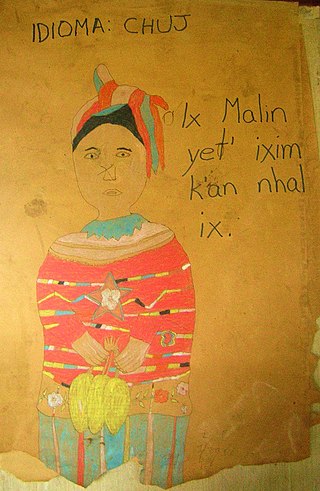Top Qs
Timeline
Chat
Perspective
Chuj language
Mayan language spoken in Guatemala and Mexico From Wikipedia, the free encyclopedia
Remove ads
Chuj (Spanish: [tʃux]) is a Mayan language spoken by around 40,000 members of the Chuj people in Guatemala and around 3,000 members in Mexico. Chuj is a member of the Qʼanjobʼalan branch along with the languages of Tojolabʼal, Qʼanjobʼal, Akateko, Poptiʼ, and Mochoʼ which, together with the Chʼolan branch, Chuj forms the Western branch of the Mayan family. The Chujean branch emerged approximately 2,000 years ago.[3] In Guatemala, Chuj speakers mainly reside in the municipalities of San Mateo Ixtatán, San Sebastián Coatán and Nentón in the Huehuetenango Department. Some communities in Barillas and Ixcán also speak Chuj. The two main dialects of Chuj are the San Mateo Ixtatán dialect and the San Sebastián Coatán dialect.[4]
The Chuj language has been influenced by Spanish, and Chuj speakers have a tendency to borrow Spanish words or code-mix. It is estimated that 70% of the Chuj language is purely Chuj.[5] There are language conservation and revitalization efforts taking place in San Mateo Ixtatán, through groups like the Academia de Lenguas Mayas de Guatemala.[6]
Remove ads
Phonology
Phonemic inventory
Remove ads
Orthography
The letter 'h' is conventionally used in words with initial vowels to distinguish them from words that begin with a glottal stop.
Remove ads
Grammar
Summarize
Perspective
Verb stem morphology
Below is a template for the verbal stem in Chuj. Verbal predicates in Chuj appear with a status suffix: -a with transitive verbs and –i with intransitive verbs. Finite clauses inflect for Tense-Aspect, person, and number.[10]
Tense/aspect/mood tz- IPFV Absolutive marker ach- 2SG.ABS Ergative marker in- 1SG.ERG Verb root chel- hug Status suffix aʼ TR tzachinchela' 'I am hugging you.' |
Non-verbal predicates
Non-verbal predicates are non-verbal words like adjectives, nouns, positionals, or directionals that act as the main predicate and are semantically stative. These constructions do not inflect for Tense-Aspect, but do inflect for person and number.[11] There is no overt copula in Chuj and copula constructions are expressed through non-verbal predicates.
a
top/foc
ix
CL
Malin
Maria
kʼaybʼum
teacher
ix.
CL
Maria is a teacher.
Ay
top/foc
ix
CL
hin-nun
my-mother
niwakil
large
ix.
CL
My mother is large.
Person-markers
Chuj is an ergative-absolutive language. The subject of an intransitive verb and the object of a transitive verb are both cross-referenced with an absolutive marker, which appears in the verbal stem. The subject of a transitive verb is cross-referenced with an ergative marker in the verbal stem.
Tense-Aspect
Chuj has four attested Tense-Aspect markers.[9][12] Finite clauses inflect obligatorily for Tense-Aspect.
Nominal classifiers
Chuj nominal classifiers represent a closed class of approximately a dozen words. They specify gender for humans, and the base material for objects, such as wood (teʼ) for houses and metal (kʼen) for knives.
Chuj nominal classifiers have two main functions: they act as articles for referential nouns, and as pronouns. They have a lexical origin, but have undergone semantic bleaching and may therefore refer to a larger semantic field than the nominals that they are derived from.
- Articles for referential nouns
Hebʼ
PL
winh
CL.MASC
unin
child
ix-s-loʼ
PFV-a3s-eat
[teʼ
CL.wood
manzan]
apple
hebʼ
PL
winh.
CL.MASC
As for the boys, they ate the apple.
- Pronouns
Ol-s-lo
Prosp-b3s-a3s-eat
teʼ
CL.wood
ix.
CL.FEM
She (Elsa) will eat it (the apple).
Numbers 1 through 10 in Chuj
A tongue twister in Chuj from San Sebastián Coatán
Source:[14]
Nokʼ Xankatat yetʼ nokʼxeʼen
Xenhxni xekxni xanhxni hinbʼeyi
Xankatak xanhbʼ wekʼ a stixalu
Xchi nokʼ xankat a nokʼ xeʼen,
Xwila xwabi, xelabʼa to ojinwekla,
to jinxekla manhx ojinwekla.
Remove ads
Sample text
Notes
References
External links
Wikiwand - on
Seamless Wikipedia browsing. On steroids.
Remove ads

